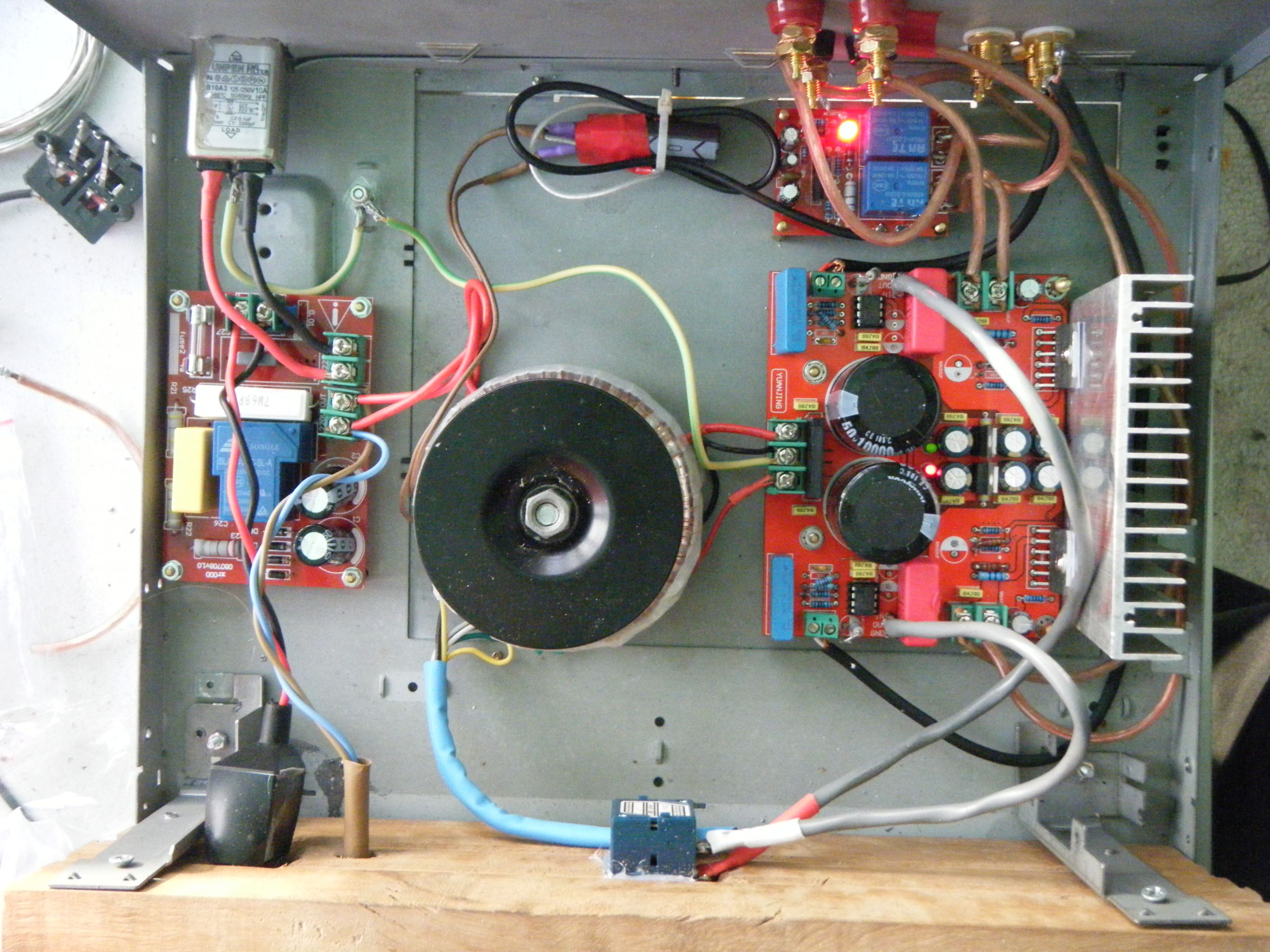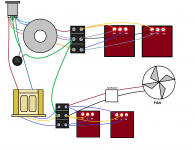Hello,
I am finally ready to wire up my big amp project. It's grown from what I originally intended, but that's alright. There are 5 parts essentially. one left and right channel board, one subwoofer board, one subwoofer preamp board, one headphone amp, and one fan. There are two transformers. A 25/25VAC torroid and a 6V-0-6V center tapped trafo.
That's what I need to wire. The biggest "problem" is that I am in a WOODEN chassis. I've attached a diagram on how I think I would wire it up going off what I have learned.
The main concern is, "Did I wire protective earth correctly?". Of course the IEC would be fused, and switched, but for simplicity's sake, I'm leaving it like that.

Thanks.
I am finally ready to wire up my big amp project. It's grown from what I originally intended, but that's alright. There are 5 parts essentially. one left and right channel board, one subwoofer board, one subwoofer preamp board, one headphone amp, and one fan. There are two transformers. A 25/25VAC torroid and a 6V-0-6V center tapped trafo.
That's what I need to wire. The biggest "problem" is that I am in a WOODEN chassis. I've attached a diagram on how I think I would wire it up going off what I have learned.
The main concern is, "Did I wire protective earth correctly?". Of course the IEC would be fused, and switched, but for simplicity's sake, I'm leaving it like that.
Thanks.
Attachments
Last edited:
Hi, technically I can't fault what you have shown, but I hate it because it gives the impression that you have put a CL60 in the PE route.
You and anyone reading your diagram must realise that the PE (in your system) is the earth tag on the IEC socket. Everything else after the CL60 is PSU zero Volts and/or Main Audio Ground. These parts are NOT part of the PE system.
If you agree then it would be wise to label your diagram accordingly.
Next:
Have you connected all exposed conductive parts to Safety Earth?
Is the IEC socket enclosure connected to PE (it is probably soldered but worth checking.
Do you consider it necessary to "earth" the small EI frame?
Will a mains fault route that touches any internal parts survive long enough to rupture the mains fuse and allow time for the arc to extinguish? This route may have to pass in excess of 1kA.
You and anyone reading your diagram must realise that the PE (in your system) is the earth tag on the IEC socket. Everything else after the CL60 is PSU zero Volts and/or Main Audio Ground. These parts are NOT part of the PE system.
If you agree then it would be wise to label your diagram accordingly.
Next:
Have you connected all exposed conductive parts to Safety Earth?
Is the IEC socket enclosure connected to PE (it is probably soldered but worth checking.
Do you consider it necessary to "earth" the small EI frame?
Will a mains fault route that touches any internal parts survive long enough to rupture the mains fuse and allow time for the arc to extinguish? This route may have to pass in excess of 1kA.
Great drawing! Looks good. Where you've separated the earth and circuit grounds with the CL-60, I have also seen other components in parallel in that location. A 0.1uF capacitor will short high frequency (RF) signals to ground. A diode from earth to circuit and another diode from circuit to earth act as a protective circuit in case of a major problem.Power Supply for Power Amplifiers
Thanks everyone.
Andrew,
I know I've asked this many times, but in a wooden case like this, PE is not connecting up to the 0V/Ground at all?
This is a picture from a thread called "Yuanjing" Gainclone 3886...this board is one of the boards I'm using. Notice how PE was connected here. This is incorrect?

So where does CL-60 go?
Thanks.
Boofers,
Thanks. I'll definitley look at that. Westhost/ESP is a great site.
Andrew,
I know I've asked this many times, but in a wooden case like this, PE is not connecting up to the 0V/Ground at all?
This is a picture from a thread called "Yuanjing" Gainclone 3886...this board is one of the boards I'm using. Notice how PE was connected here. This is incorrect?

So where does CL-60 go?
Thanks.
Boofers,
Thanks. I'll definitley look at that. Westhost/ESP is a great site.
Post 4 shows the PE directly connected to chassis. This is correct. OOPS, I had a closer look. That seems to be a soldered joint. That is not adequate.
Post1 shows a green wire from PE to small transformer Zero Volts terminal via, CL60 and via toroid Zero Volts. Since these are all the same colour, your description and the drawing give the mistaken impression that all the GRN wires are PE.
The PE is only the 1/4" spade. The IEC socket casing is electrically connected via a soldered joint. Theoretically since this is not a mechanical joint this is technically not part of the Safety Earth. However in practice that solder joint is unlikely to ever melt and thus the socket casing is effectively directly connected to the PE.
The green wires are not the PE. The Green wires are PSU Zero Volts.
Post1 shows a green wire from PE to small transformer Zero Volts terminal via, CL60 and via toroid Zero Volts. Since these are all the same colour, your description and the drawing give the mistaken impression that all the GRN wires are PE.
The PE is only the 1/4" spade. The IEC socket casing is electrically connected via a soldered joint. Theoretically since this is not a mechanical joint this is technically not part of the Safety Earth. However in practice that solder joint is unlikely to ever melt and thus the socket casing is effectively directly connected to the PE.
The green wires are not the PE. The Green wires are PSU Zero Volts.
Alright. I think I understand. So everything from the IEC to the CL-60 is protective earth, whilst everything after that is 0V/Return/Ground?
What is your opinion about using the ESP method? 2 diodes, 10R resistor, and a 100nF cap? VS using a CL-60? I have a CL-60, and I probably have the components for the ESP method....
So, is there a "better" one?
Thank you very much.
What is your opinion about using the ESP method? 2 diodes, 10R resistor, and a 100nF cap? VS using a CL-60? I have a CL-60, and I probably have the components for the ESP method....
So, is there a "better" one?
Thank you very much.
Hi,
The "ESP method" appears to have been copied from this Forum. It was a new addition to his site after we had been discussing it for some months. It was nice to see that Rod could sift the wheat from the chaff and do an accurate paper on "how to". EXCEPT, the diagram shows PE going to the rectifier instead of the chassis.
I have only ever tested the big bridge rectifier//small ceramic//small resistor. It passed without any "apparent" damage. Judging by the condition of the fuseholder and the fuses, or what I could find of them, after the explosion, it was a mighty test.
You or someone else would need to repeat that test to get the comparison you are asking for.
The "ESP method" appears to have been copied from this Forum. It was a new addition to his site after we had been discussing it for some months. It was nice to see that Rod could sift the wheat from the chaff and do an accurate paper on "how to". EXCEPT, the diagram shows PE going to the rectifier instead of the chassis.
I have only ever tested the big bridge rectifier//small ceramic//small resistor. It passed without any "apparent" damage. Judging by the condition of the fuseholder and the fuses, or what I could find of them, after the explosion, it was a mighty test.
You or someone else would need to repeat that test to get the comparison you are asking for.
- Status
- This old topic is closed. If you want to reopen this topic, contact a moderator using the "Report Post" button.
- Home
- Amplifiers
- Power Supplies
- Final verification of Protective Earth wiring
